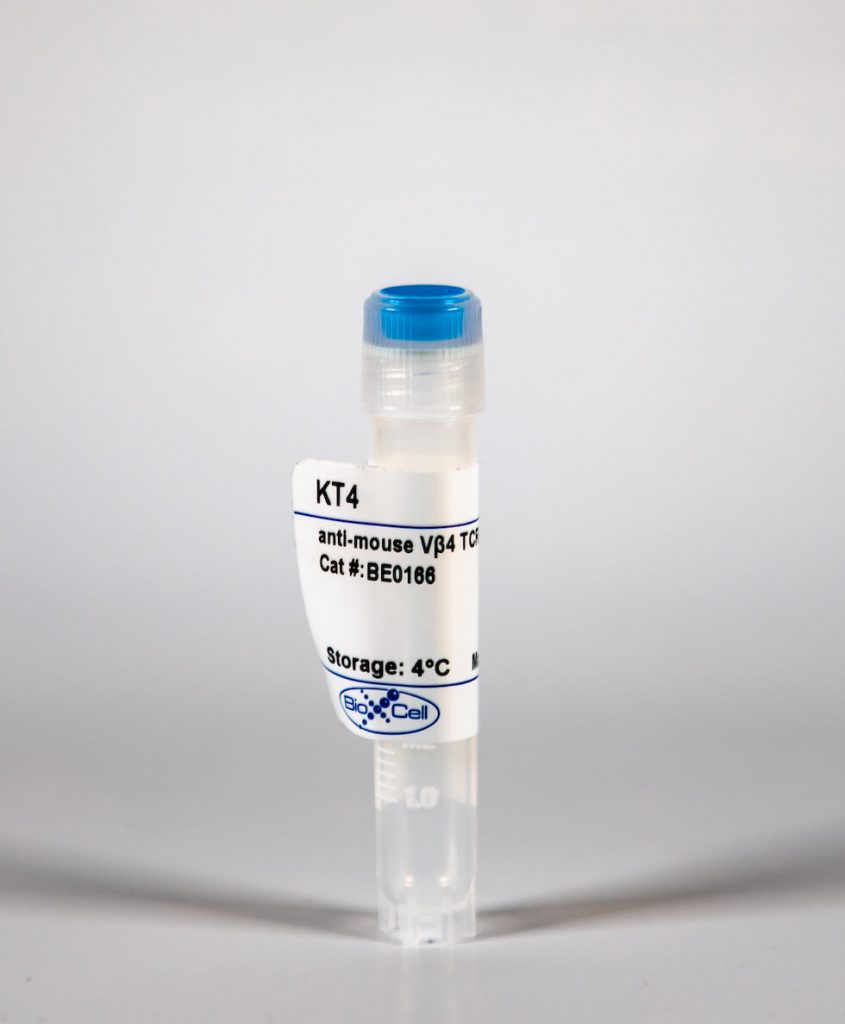InVivoMab anti-mouse Vβ4 TCR
| Clone | KT4 | ||||||||||||
|---|---|---|---|---|---|---|---|---|---|---|---|---|---|
| Catalog # | BE0166 | ||||||||||||
| Category | InVivoMab Antibodies | ||||||||||||
| Price |
|
The KT4 monoclonal antibody reacts with the Vβ4 TCR (V beta 4 T cell receptor) of most known mouse strains. Vβ4 TCR-expressing cells are CD4 autoreactive T cells which induce autoimmune thyroiditis after elimination of regulatory T-cell subsets. Plate-bound KT4 antibody has been shown to activate Vβ4 TCR-expressing T cells.'
| Isotype | Rat IgG2b |
| Recommended Isotype Control(s) | InVivoMAb rat IgG2b isotype control, anti-keyhole limpet hemocyanin(BE0090) |
| Recommended InVivoPure Dilution Buffer | InVivoPure pH 7.0 Dilution Buffer(IP0070) |
| Immunogen | KT4 B10.D2 mouse T cell clone I3 |
| Reported Applications |
|
| Endotoxin |
|
| Purity |
|
| Formulation |
|
| Sterility | 0.2 μM filtered |
| Production | Purified from tissue culture supernatant in an animal free facility |
| Purification | Protein G |
| Storage | The antibody solution should be stored at the stock concentration at 4°C. Do not freeze. |
| RRID | AB_10950191 |
| Molecular Weight | 150 kDa |
InVivoMAb anti-mouse Vβ4 TCR (Clone: KT4)
Beus, J. M., et al. (2013). "Heterologous immunity triggered by a single, latent virus in Mus musculus: combined costimulation- and adhesion- blockade decrease rejection." PLoS One 8(8): e71221. PubMed
The mechanisms underlying latent-virus-mediated heterologous immunity, and subsequent transplant rejection, especially in the setting of T cell costimulation blockade, remain undetermined. To address this, we have utilized MHV68 to develop a rodent model of latent virus-induced heterologous alloimmunity. MHV68 infection was correlated with multimodal immune deviation, which included increased secretion of CXCL9 and CXCL10, and with the expansion of a CD8(dim) T cell population. CD8(dim) T cells exhibited decreased expression of multiple costimulation molecules and increased expression of two adhesion molecules, LFA-1 and VLA-4. In the setting of MHV68 latency, recipients demonstrated accelerated costimulation blockade-resistant rejection of skin allografts compared to non-infected animals (MST 13.5 d in infected animals vs 22 d in non-infected animals, p<.0001). In contrast, the duration of graft acceptance was equivalent between non-infected and infected animals when treated with combined anti-LFA-1/anti-VLA-4 adhesion blockade (MST 24 d for non-infected and 27 d for infected, p = n.s.). The combination of CTLA-4-Ig/anti-CD154-based costimulation blockade+anti-LFA-1/anti-VLA-4-based adhesion blockade led to prolonged graft acceptance in both non-infected and infected cohorts (MST>100 d for both, p<.0001 versus costimulation blockade for either). While in the non-infected cohort, either CTLA-4-Ig or anti-CD154 alone could effectively pair with adhesion blockade to prolong allograft acceptance, in infected animals, the prolonged acceptance of skin grafts could only be recapitulated when anti-LFA-1 and anti-VLA-4 antibodies were combined with anti-CD154 (without CTLA-4-Ig, MST>100 d). Graft acceptance was significantly impaired when CTLA-4-Ig alone (no anti-CD154) was combined with adhesion blockade (MST 41 d). These results suggest that in the setting of MHV68 infection, synergy occurs predominantly between adhesion pathways and CD154-based costimulation, and that combined targeting of both pathways may be required to overcome the increased risk of rejection that occurs in the setting of latent-virus-mediated immune deviation.






